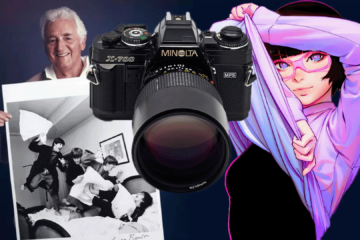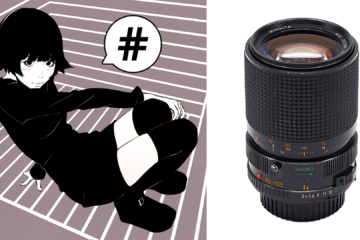Minolta MD 50-135mm 1:3.5 Zoom – review

Minolta MD 50-135mm 1:3.5 Zoom lens review
- Official classification: New-MD
- Collector’s classification: MD III
The very special zoom because of unusual behavior. But with an absolutely clear purpose – this is a great tool for portraiture.
Tests for this review are divided for 50mm, 80mm, 135mm groups.
Minolta MD 50-135mm 1:3.5 Zoom specifications:
| # in minolta.eazypix.de index | 268 |
| Name engraved on lens | MD ZOOM |
| f[mm] | 50-135 |
| A max [1/f] | 3.5 |
| A min[1/f] | 32 |
| Lens design [el.] | 12 |
| Lens design [gr.] | 10 |
| Filter thread Ø front(rear)[mm] | 55 |
| Lens Shade | clip-in |
| closefocus[m/ft] | 1.5/5 |
| Dimension Ø x length [mm] | 68.5×118 |
| Weight[g] | 480 |
| Year | 1981 |
| Style | MD III |
| Code No. (ROKKOR-X) or Order No. | 677-810 |
| Notes |
More Data
| Floating elements | YES |
| Aperture blades number | 6 |
| Average international price (sold items) | 2019: USD 50-75 |
| Reviewed Lens SN: | 8010506 |
This lens has been produced in two incarnations – the latest New-MD version and the previous one which is labeled as ROKKOR. Or Minolta MD-II and MD-III styles by the popular collector’s classification. There are no optical and mechanical differences, just little changes in the exterior. My heart is always on the side of New-MD lenses, so I’ve got the latest MD-III modification.
Minolta MD 50-135mm 1:3.5 Zoom lens exterior:
Lens Shade (or Lens Hood):
Minolta MD 50-135mm 1:3.5 Zoom mounted on camera Minolta X-700
Minolta MD 50-135mm 1:3.5 Zoom Macro sharpness
Сlose-distance resolution test, minimal distance
Testing methods description
- Target: 10-15 cm picture, printed on glossy photo paper
- Distance: 1.7m
- Camera: Sony A7II (24mpx, full-frame, tripod, remote control). M-mode, ISO fixed, WB fixed, SteadyShot – OFF.
- The test was repeated for every F-stop on every focus position with manual focus adjustment for each shot. That is to avoid the effect of field curvature.
- RAW processing: Capture One, default settings. All quality settings – 100%. Crops – 300×200 px
Original target image (printed in horizontal orientation on 10cm X 15cm glossy photo paper
Long-distance resolution test
Testing methods description
- Target: cityscape
- Distance: > 200 meters to center focus point
- Camera: Sony A7II (24mpx, full-frame, tripod, remote control). M-mode, ISO fixed, WB fixed, SteadyShot – OFF. The focus point is on the center only.
- RAW processing: Capture One, default settings. All quality settings – 100%. Crops – 300×200 px
Minolta MD 50-135mm 1:3.5 Zoom TEST RESULTS on FOCUS DISTANCE = 50mm
50mm – Sharpness – a short distance
Scene preview
50mm – Test results
50mm – Sharpness – long distance
50mm – Scene preview
50mm – Test results
50mm – Vignetting
50mm – Geometric distortion
50mm – Coma aberrations
50mm – Chromatic aberrations
50mm – Long-distance bokeh
Test #1
Test conditions: the lens was focused on 1.5m, buildings are on “infinity”-distance
50mm – Light bubbles bokeh
Test #1
The lens is on the minimal focusing distance 1.5m, lights are on infinity (cityscape)
Minolta MD 50-135mm 1:3.5 Zoom TEST RESULTS on FOCUS DISTANCE = 80mm
80mm – Sharpness – short distance
80mm – Scene preview
80mm – Test results
80mm – Sharpness – long distance
80mm – Scene preview
80mm – Test results
80mm – Vignetting
80mm – Geometric distortion
80mm – Coma aberrations
80mm – Chromatic aberrations
80mm – Long-distance bokeh
Test#1
Test conditions: lens was focused on to minimal distance 1.5m, buildings are on “infinity”-distance
80mm – Light bubbles bokeh
Test #1
The lens is on the minimal focusing distance 1.5m, lights are on infinity (cityscape)
Minolta MD 50-135mm 1:3.5 Zoom TEST RESULTS on FOCUS DISTANCE = 135mm
135mm – Sharpness – short distance
135mm – Scene preview
135mm – Test results
135mm – Sharpness – long distance
135mm – Scene preview
135mm – Test results
135mm – Vignetting
135mm – Geometric distortion
135mm – Coma aberrations
135mm – Chromatic aberrations
135mm – Long-distance bokeh
Test#1
Test conditions: the lens was focused on 1.5m, buildings are on “infinity”-distance
Test#2:
Test conditions: lens was focused on 3m (half of the scale), houses were fixed in infinity distance on the ground.
135mm – Light bubbles bokeh
Test #1
The lens is on the minimal focusing distance 1.5m, lights are on infinity (cityscape)
Minolta MD Zoom 50-135mm F3.5 – final conclusion
This zoom covers all the most popular portrait focal lengths. It’s convenient. I just don’t like some lack of sharpness, but note: sharpness falls in the corners strongly, but the middle looks good or, better to say – it’s enough, because in portraiture photography objects usually are located in the middle or center. But as a reviewer, I have to say that the sharpness of the lens (my tested copy) is not as good as one would expect. In other words – the lens is mostly for photographers, not for pixel peepers.
Aberrations
The lens hasn’t noticeable vignetting, chromatic or coma. Of course, aberrations are presented and this zoom isn’t ideal but everything is inside of ‘standard borders’ for Minolta, it means – much better than average level. The geometric distortion is also can be called as noticeable or better to say – very noticeable, but again – nothing special, most of the zooms have an issue with geometry. And it is very strange because, you know, the most interesting bokeh is provided by lenses with big aberrations… And here are the question – what about the bokeh of that zoom?
My first expression after I saw the result of the test was like: ‘The portrait zoom with swirly bokeh? Interesting…’
‘Swirly’ is the most contradictory type of bokeh. On the one hand – it is very striking and motley. It looks strange at least and pulls the attention of spectators from the main object. On the other hand – in some rare cases this feature can underline the main object. The examples of famous lenses with swirly bokeh are Carl Zeiss Jena Biotar 75mm F/1.5 and Helios 40-2 85mm F/1.5. The tested Minolta 50-135 F/3.5, of course, is not so cool but can show something like.
As a result
Yes, this lens shows a small lack of sharpness and uneven sharpness distribution over the frame. But I can easily imagine a photographer who will love this lens because of the nice rendering in the complex with the specifically portrait focal distances diapason. The swirly effect is not as pronounced as that of Zeisses or Helioses etc, but is still present.
I can’t say something like “strongly recommend as a main portraiture tool for photographers”, but at least it’s worth a try – because of convenient focal distances, good IQ in right zones of a frame, and unusual rendering. In addition, this is quite a cheap lens. An experiment is needed, suddenly you will like it – definitely, the lens stays in the top half among other portrait-zooms.





















































2 Comments
jens · 2022-10-08 at 11:02
Thanks for reviewing this lens !
The portrait primes are extremely expensive, e.g. Rokkor 85mm or 100mm,
so i will purchase this portrait zoom ( about 35 Euros ).
i tried a Tokina ATX 60-120mm before but it is unsharp ( i shoot analog cameras only )
The results in your Rokkor 50-135mm review are very convincing for my opinion.
Tony · 2022-10-08 at 17:09
Thank you. I agree, it looks like a good choice instead of expensive primes. BTW, 75-150/4 is even sharper